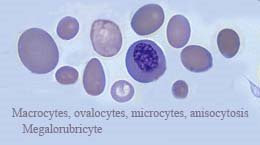Pernicious anemia (a specific megaloblastic anemia), one of the macrocytic anemias, is the consequence of a deficiency of vitamin B12 or its absorption and folic acid. This anemia is caused by impaired DNA synthesis, which leads to the megaloblastic transformation of erythroid precursors. The defective DNA synthesis retards nuclear maturation and causes abnormal mitotic activity which causes the cells to divide too rapidly. The nuclei tend to be large with loosely arranged chromatin material. It is not unusual to observe satellite nuclear pieces in these cells. The cytoplasm maturates at different rates and hemoglobin synthesis is also affected. This abnormal bone marrow environment is characterized by increased cellular destruction and ineffective hematopoiesis.
Cells that are released into peripheral circulation tend to be large and oval in shape. The RBC “picture” may be featured with poikilocytosis and an increased number of dacryocytes. The immature granulocytic cells undergo significant changes. The metamyelocyte tends to be large with a horseshoe shaped nucleus. Neutrophils present with hypersegmentation. The mega-myelocytes tend to be hyposegmented or the nuclear lobes are widely separated. Clinical observations include: [1] increased MCV, [2] macrocytes, [3] anisocytosis, [4] poikilocytosis, [5] hypersegmentation, [6] leukopenia, and [7] thrombocytopenia.
Cells that are released into peripheral circulation tend to be large and oval in shape. The RBC “picture” may be featured with poikilocytosis and an increased number of dacryocytes. The immature granulocytic cells undergo significant changes. The metamyelocyte tends to be large with a horseshoe shaped nucleus. Neutrophils present with hypersegmentation. The mega-myelocytes tend to be hyposegmented or the nuclear lobes are widely separated. Clinical observations include: [1] increased MCV, [2] macrocytes, [3] anisocytosis, [4] poikilocytosis, [5] hypersegmentation, [6] leukopenia, and [7] thrombocytopenia.
Pernicious anemia (PA), as a rule, only occurs when there is impaired vitamin absorption due to the loss of intrinsic factor, which will combine with the vitamin to form a soluble intrinsic-vitamin B12 complex, where it is absorbed in the terminal portion of the ileum. PA will present with the following symptoms: [1] weakness, [2] pallor, [3] giddiness, [4] anorexia, [5] diarrhea, [6] constipation, [7] glossitis, [8] tachycardia, [9] splenomegaly, and/or [10] hepatomegaly. Causes of defective absorption are; [1] celiac disease, [2] peptic ulcer, [3] stomach cancer, [4] Crohn’s disease, [5] the parasite, Diphyllobothrium latum.
PA occurs frequently in patients with [1] thyroidtoxicosis, [2] Hashimoto’s thyroiditis, [3] rheumatoid arthritis, and [4] gastric carcinoma. Failure to treat this anemia may lead to spinal cord disease and may result in irreversible ataxia. PA usually responds well to treatment.
Clinical laboratory findings:
[1] As a rule, the laboratory test results are similar to that for megaloblastic anemia.[2] Additional test results that should be examined:A. On the bone marrow film, look for megakaryocytes that have a loose or exploded type of nucleus.
[3] Peripheral blood film findings include any or all of the following:
- Oval macrocytes
- Howell-Jolly Bodies
- Moderate to severe anisocytosis
- NRBC’s
- Variable poikilocytosis
- Cabot rings
- Hyper-segmented neutrophils
- Large platelets
- Schistocytes.
[4] The bone marrow review will be characterized by: hypocellularity with an increase in erythroid precursors, megaloblasts, giant size metamyelocytes and bands, and the ME ratio = 1:1 to 1:3 (normal = 1.5:1 to 4:1)

1 comment:
Im taking your feed also, Thanks.
anisocytosis definition
Post a Comment